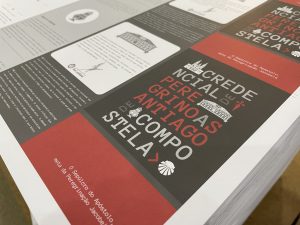Discover the many ways to add value to your company’s visual communication using one of the most aesthetically and functionally versatile materials: vinyl!
Let’s clarify right away—we’re not talking about music (although that’s always an appealing topic!).
The vinyl we’re discussing here is a special adhesive material, and we’ll explore various ideas for its use and application. As you read through this article, we invite you to imagine how you might apply these suggestions to your own company or brand. Ready?
What Is Vinyl?
This material is highly sought after by clients. Because it’s made from a type of plastic, it is extremely resistant, flexible, and durable. So much so that even if you try to tear it with full force, you’ll hardly succeed—instead of ripping, it stretches (with the exception of monomeric vinyl, as we’ll see shortly).
Vinyl comes in two main types: printable and cut vinyl. As the name suggests, printable vinyl is designed to hold ink— but not just any ink. Since it's plastic, it can’t be printed using a regular printer. It’s available in various coatings, each suited to a specific type of printing.
Cut vinyl, on the other hand, is not meant to absorb ink. It already comes in a wide range of colours and is simply cut into the desired shapes—letters, symbols, and more—using specialized machines. It’s commonly used for signage, storefronts, windows, and vehicle decoration.



Types of Adhesive Vinyl and Their Applications
Whether for printing or cutting, vinyl is typically classified into three categories based on its molecular composition: monomeric, polymeric, and cast.
Monomeric Vinyl
Monomeric vinyl is the most affordable and thickest type—hence, less flexible. If you try to tear it, it won’t stretch; it will break. Despite this limitation, it’s a great choice for billboards, for example—since the message is viewed from afar, a minor 1cm misalignment won’t be noticeable. It's also frequently used in short-term advertising campaigns. In ideal conditions, its maximum lifespan can reach up to 5 years.
Polymeric Vinyl
If your project requires more precision—say, decorating a truck with mild curves where different parts must align perfectly— polymeric vinyl is the way to go.This material is more stable, mid-range in cost, and has a lifespan of 8 to 10 years.
Cast Vinyl
Monomeric Cast vinyl is ideal for high-precision applications, such as decorating vehicles with pronounced curves.
Here, maximum flexibility is crucial, so the vinyl can fully conform to every surface contour without compromising adhesion.
This is considered a high-performance material and is, naturally, the most expensive option—lasting up to 10 years.



Where Can You Apply Vinyl?
Adhesive vinyl can be applied to a variety of smooth surfaces, such as glass, wood, painted walls, metal sheets, acrylic, PVC, and even over previously installed vinyl.
This versatility makes it ideal for use on storefronts, retail windows, indoor and outdoor signage, vehicle wraps, corporate environments, and promotional events.
However, to ensure effective and long-lasting application, it’s crucial that the surface is completely clean, dry, and free of any impurities like dust, grease, moisture, or small irregularities.
Even minor bumps or residual particles can interfere with adhesion, causing issues like peeling, air bubbles, or early detachment.
For outdoor applications—where exposure to sun and rain is constant—using vinyl with UV protection or lamination is strongly recommended to enhance durability and resistance.









Benefits of Vinyl in Visual Communication
Adhesive vinyl offers several strategic advantages for brands and businesses seeking to strengthen their visual identity efficiently and affordably:
- Versatile application: Adapts to various shapes and surfaces
- Non-damaging to surfaces: Ideal for temporary setups or rented spaces
- Highly durable: Options with lifespans of up to 10 years
- Excellent cost-effectiveness: More affordable than traditional painting or signage
- Easy to install and remove: No need for major renovations
- Immediate visual impact: Enhances brand visibility at the point of sale
Additionally, vinyl is an eco-friendly solution when used with sustainable inks and, in some cases, can be recycled—contributing to green marketing initiatives.



It’s important to remember that humans are 80% visual, which means how you present your products and services is critical to success. By choosing the right materials wisely, businesses can stand out and make a strong impression on their customers—a key factor in winning them over and building loyalty.
We’d love to hear your thoughts! Have you considered using vinyl in your communication materials?
Minerva specializes in visual communication solutions that combine creativity, technology, and technical excellence.
Contact us to learn more!



